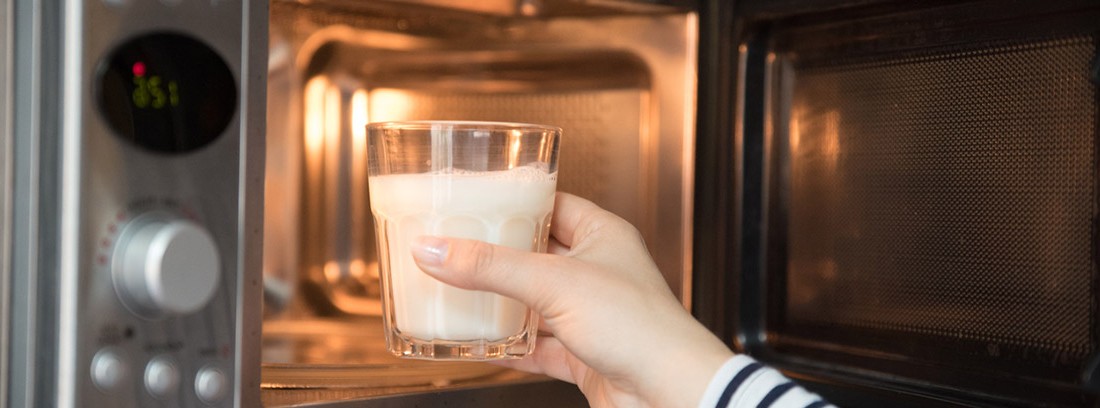How do you heat a microwave?

Microwaves are a type of low-energy radiation, the waves of which are directed into the appliance through an opening and bounce off the metal walls, reflecting towards the food.
In those, the heat is applied from the outside of the food, to the inside. In microwave cooking, food heats up very quickly that is why it is important that the plane rotate, to distribute the heat and that the cooking is homogeneous. It is also advised close the containers where the food is cooked to concentrate the steam inside and thus facilitate cooking. Be careful, but never in a hermetic way because it would explode!
Does cooking in the microwave change the quality of food?
There are many myths about foods that cannot be put in the microwave, but studies on the loss of nutrients from foods cooked in the microwave, say otherwise. The main factors that affect the integrity of nutrients are:
- Cooking water usage and time: the longer and more water used for cooking, the more nutrients are lost, so more vitamins will be lost water soluble boiling a cabbage that cooked in the microwave.
- Temperature reached: the microwave temperature is not very high and the energy penetrates quickly inside the food, therefore cooking time is reduced.
The conclusion is that the differences between cooking with the oven, gas stove, electric, induction or microwave, does not produce significant differences with regard to the quality and quantity of nutrients. Despite this, we must bear in mind that there are some foods that it is not advisable to cook in the microwave
What foods should not be heated in the microwave?
Hard-boiled egg
Putting a whole egg in the microwave can do it exploit. This process occurs because energy passes through the egg shell very quickly, generating a pocket of water inside the yolk that, when superheated above the boiling temperature, can explode the egg at any time, either in the microwave. or off when piercing. The best option is cook it with other foods, such as vegetables, breaking the shell and cooking it as if it were grilled or scrambled.
Chocolate
Microwave cooked chocolate it's burning very easily since it hardly contains water; It doesn't explode or anything like that, but it burns very quickly. In the case of doing so, it is advisable to melt at a low temperature and stop the microwave every three seconds to stir it and prevent it from burning. Another option is add a finger of water or milk to avoid burning
Chilli Peppers
The heating of the cells causes a substance called capsaicin, which volatilizes and disperses quickly, especially when opening the microwave door, which can cause irritation to the eyes and throat and even bad breath.
Grapes
The spherical shape of the grape together with its waxy and resistant skin causes the effects of the waves on them to create a “mini” explosion that will affect the operation of the device.
What materials should not be put in the microwave?
We must not forget to choose the one, as it is as important as the food. Containers of glass, stoneware containers and plates ceramic, silicone, or microwave safe food plastics (You must specify it at the bottom of the container).
Metals in the microwave
We have always heard that putting something metallic in the microwave would cause an explosion, as a general rule metals should not be put in the microwave, but it is important to know not only the type of metal, but also the size and shape.
Most of the kitchen utensils that we have are made of aluminum or stainless steel, but this is not the most important thing, but what shape it is. A fork is much more dangerous than a spoon, if we forget a spoon by mistake, it will most likely overheat and little else, on the contrary, a fork, due to its shape makes the impact of the waves between the metal particles much faster and more intense, causing sparks
Wood in the microwave
Wooden utensils, such as chopsticks, accumulate a large amount of easily flammable heat that can spread to the entire equipment, therefore it is not advisable to put wood in the microwave.
- In 2005 the World Health Organization (WHO) published a document explaining that the microwave is safe and convenient for heating and preparing food for consumption, provided it is used according to the manufacturer's instructions.
- There are many myths about how it affects cooking food in the microwave, but the reality is that the differences are not significant with respect to the quality and quantity of nutrients.
- Despite this, we must take into account the type of material that we put in the microwave and that it is not recommended to use it for certain foods.
Diploma in Human Nutrition and Dietetics
Master in Pediatric Nutrition and Sports Nutrition
(Updated at Apr 13 / 2024)